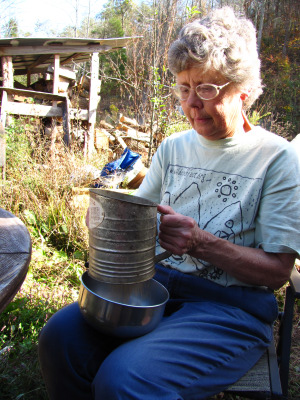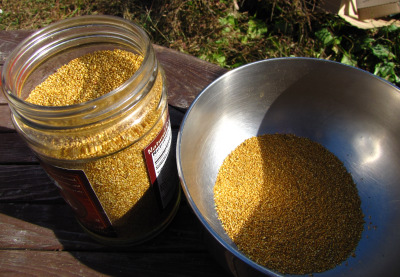
How to winnow amaranth
 "How
would you like to come over and help me thresh
amaranth?" I asked
my mom, and she gamely agreed. She was a great help as we worked
through two big grocery bags of seed heads, but when it came time to
winnow, Mom clearly didn't think too much of my bowl method.
Instead, she suggested that I use my flour sifter to separate the seeds
from the chaff.
"How
would you like to come over and help me thresh
amaranth?" I asked
my mom, and she gamely agreed. She was a great help as we worked
through two big grocery bags of seed heads, but when it came time to
winnow, Mom clearly didn't think too much of my bowl method.
Instead, she suggested that I use my flour sifter to separate the seeds
from the chaff.
Sure enough, amaranth
seeds are just small enough to drop through the holes in the mesh
bottom while most of the chaff stays up in the chamber to be dumped
out. Sifting is also considerably faster than the bowl method
since one round in the sifter is equivalent to several rounds of
pouring the seeds from bowl to bowl.
After a great deal of
trial and error, we figured out that a combination of the bowl method
and the sifter method are best for winnowing amaranth. We would
sift a time or two, then use the bowl method to remove the chaff small
enough to fit through the screen. Then, if we felt like it, we
might sift again to get the seeds really clean.
 Once
our seeds were winnowed, Mom noticed another potential problem ---
there were dozens of tiny bugs wandering around on our amaranth
kernels. I've read that you can bake grain in the oven for a
short time to kill bugs before storing it, but I want to be able to
save some of the seeds to plant next year. So I popped the grain
in the freezer instead, and also plan to eat our amaranth over the next
month or two rather than doling it out over the next year.
Once
our seeds were winnowed, Mom noticed another potential problem ---
there were dozens of tiny bugs wandering around on our amaranth
kernels. I've read that you can bake grain in the oven for a
short time to kill bugs before storing it, but I want to be able to
save some of the seeds to plant next year. So I popped the grain
in the freezer instead, and also plan to eat our amaranth over the next
month or two rather than doling it out over the next year.
Total harvest from one
garden bed was 3.5 cups and we took about an hour or two to process it
(but we weren't in any hurry.) I'm thrilled by the harvest and by
the relative ease of processing our first real batch of homegrown
grains. We
will definitely expand our amaranth planting next year.
Want more in-depth information? Browse through our books.
Or explore more posts by date or by subject.
About us: Anna Hess and Mark Hamilton spent over a decade living self-sufficiently in the mountains of Virginia before moving north to start over from scratch in the foothills of Ohio. They've experimented with permaculture, no-till gardening, trailersteading, home-based microbusinesses and much more, writing about their adventures in both blogs and books.
Want to be notified when new comments are posted on this page? Click on the RSS button after you add a comment to subscribe to the comment feed, or simply check the box beside "email replies to me" while writing your comment.

how do you remove the bugs from the grain then? you say you freeze it or put it in the oven. then do you pick them out?
store bought amaranth often has unhulled grains in it that are black. how to remove them? there are so many.
Generally, people just eat the bugs. I know that may sound disgusting, but I suspect most homesteaders accidentally consume a lot of bugs in their daily life, and it's really pretty good for you.
I know that may sound disgusting, but I suspect most homesteaders accidentally consume a lot of bugs in their daily life, and it's really pretty good for you.
Actually, if you freeze the grain soon after picking, chances are there's only one or two bugs, or even just a few miniscule eggs. It's only if you let those bugs breed unchecked over the winter that you get into trouble.
Not sure about black grains. Amaranth doesn't really have hulls (except the chaffy material that you thresh off, but it wouldn't look like a black grain.)